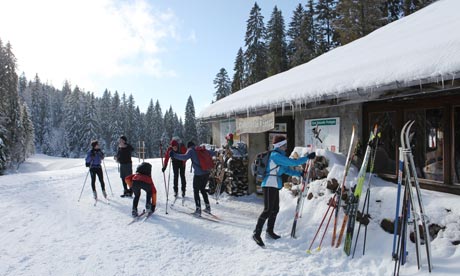
Sometimes you choose to visit a ski resort for thrillingly shallow reasons: because bits of it are steep or deep or long; because of where it is. At other times, the attraction is more subtle.
In recent years my parents have been resident in France and have raved about Les Rousses, their local ski station in the Jura mountains. One factor is that, being over 65, they qualify for free lift passes. But they also tell of the friendly atmosphere, the great food, and the fun skiing.
I'd long known the area from family trips to the "beach" at Lake Vouglans during the summer. Even then, looking at the rolling meadows and steep hills, I'd often wondered what it would be like to ski there. There was also a second factor driving my curiosity: a growing affinity with small, community resorts – the kind of places where locals go to ski, that feel part of the culture and not somehow transplanted.
Even if the Jura is low in comparison with Chamonix (about an hour and a half away), what it has to offer is unique. Weaving its way along the bottom of the downhill slopes is one of Europe's finest cross-country routes, the 175km Grande Traversée du Jura (GTJ), at the centre of an extensive network of trails you can ski in winter, or bike or walk in summer. It is along this trail that the annual 76km Transjurassienne race is staged, one of the classic cross-country ski marathons.
The plan was simple. For my wife Emily, who hasn't skied in 15 years and never on cross-country gear, it would be the first opportunity to visit a European ski destination. Before, she'd only ever skied at Indianhead Mountain on Michigan's Upper Peninsula, a place whose après-ski she summarised as: "Five banks, five titty bars and a Chinese restaurant." We'd ski a bit, eat a lot and do some cross-country touring.
Les Rousses is a pretty mountain village with a few restaurants and hotels, a couple of bars and the Arnaud family's Comté cheese-making business, based in the impressive stone-walled fort whose old ammunition cellars are now stacked ceiling-high with the strong-smelling local produce.
Staying in the centre, at the Ferme du Père François – a busy restaurant with rooms above – it was clear from the outset that Les Rousses was what I had been hoping for: a resolutely French experience. The daily diet comprised local hams and Morteau sausage, local morels, honey beer, the fortified Macvin du Jura wine, and the extraordinary liqueur de sapin, an aperitif produced in nearby Pontarlier whose distinctive flavour comes from pine-shoot tips.
The downhill skiing here is never too hard, although there are a few black runs around the surrounding mountains, and the highest peak is La Dôle, at 1,677m, straddling the French-Swiss border. But the scope of the runs is enough for a week's pisted skiing, while the off-piste runs snaking through the tightly forested slopes offer more challenging descents.
Our first day's skiing was on a Sunday. Outside the school holidays the slopes were relatively uncrowded. By the Monday, after a night of fresh powder, they were deserted. Turning up on a morning of fresh snow to an empty lift is a pleasant surprise.
If the downhill is fun, the cross-country skiing is world class, not only for gentle one-day tours and longer excursions but also – judging by the numbers training for the Transju – for dedicated racers.
We met up with François Escoffier, an Ecole du Ski Français (ESF) guide, a little out of town at one of the "portes" that access the network of cross-country trails. I'd skied cross-country before but was rusty. Emily had never tried it, but after 10 minutes of instruction she was ready to go on her first short circuit.
A day later we were undertaking a day's tour along the GTJ. This time we started at La Frasse, 15 minutes out of town below the Forêt du Massacre. We were passed in quick order by two members of the French national team on skating skis and by various high-speed pensioners, but on the whole the trail was spookily quiet. Soon we were skiing past the Chalet de la Frasse, one of the cabins that provide food and lodging for those doing the whole trail, which takes about a week. Higher up, the terrain flattened out at last before the descent towards the village of Lajoux. If there is an advantage to getting tired on cross-country skis it's that you forget to think too hard about your balance and relax into the downhill.
The following day we did a cross-country tour through the forests around the Massif du Risoux. Reaching an open area of sparse trees beside the track, we set off across a large clearing of soft hummocks. The only people we saw was a small party on snow shoes.
The charm of places like the Jura lies in what they are definitively not: resorts designed to push as many people through the slopes as possible. And what is most striking about the Jura is the sense of how its small and charming ski station feels such a part of the community and the landscape. For those reasons, I'll be back.
Essentials
Peter Beaumont travelled to Les Rousses with DFDS Seaways (dfdsseaways.co.uk), which has winter crossings from Portsmouth to Le Havre and Newhaven to Dieppe for a car plus four passengers, from £47 one way. He stayed at La Ferme du Père François (perefrancois.fr), where rooms start at €115. An Alpine ski pass for the whole Franco-Swiss area is €157 for six days. The resort also offers deals in joint Nordic/Alpine passes from €42. Further information at jura-tourism.com

